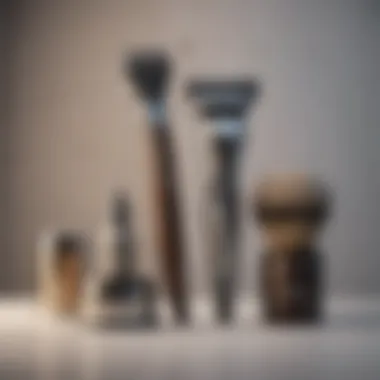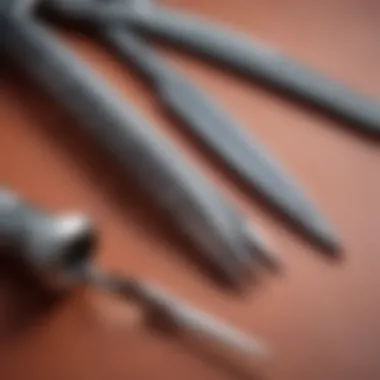Best Techniques for Trimming Pubic Hair at Home


Intro
Trimming pubic hair at home is a personal choice for many, yet it often comes with uncertainties and questions. Understanding the best methods and tools for this task can enhance personal grooming practices, ensuring safety and comfort. Whether for aesthetic reasons or hygiene, knowing how to trim effectively can empower individuals in their grooming routine.
Safely navigating this process involves not just technique but also preparation and aftercare. Factors such as skin sensitivity, hygiene, and suitable tools play crucial roles in achieving satisfactory results. This article seeks to demystify home grooming by providing clear, actionable steps for trimming pubic hair. From selecting the right tools to addressing common concerns, readers will gain insights into an often-overlooked aspect of personal care.
Establishing a grooming routine that prioritizes comfort and aesthetics can enhance confidence and well-being. Throughout this guide, we will explore effective techniques, necessary preparations, and appropriate aftercare, laying a solid foundation for a comprehensive understanding of at-home grooming.
Prelims to Pubic Hair Grooming
Pubic hair grooming is a topic often overlooked yet is integral to personal hygiene and self-care. Understanding the various aspects of grooming can enhance not only one’s aesthetic appeal but also one’s comfort and confidence. In this article, we delve into why it's essential to pay attention to this aspect of grooming, and how it intertwines with hygiene practices, cultural beliefs, and personal preferences.
Grooming pubic hair serves several purposes. Firstly, it can prevent discomfort caused by excessive hair growth. Keeping hair trimmed can reduce sweat, odor, and irritation, especially during warm weather or physical activity. Moreover, many individuals feel that grooming complements their personal style or body image, reinforcing self-esteem.
It is also important to note the practical considerations. Knowing how to properly trim pubic hair helps avoid accidental cuts, irritation, and other complications. This is where tools and techniques come into play, ensuring a safe and satisfactory grooming experience.
Understanding the Purpose of Grooming
Grooming tasks are often seen as cosmetic but go beyond mere appearance. The primary purpose of grooming pubic hair involves hygiene. Regular trimming helps maintain cleanliness. It minimizes the accumulation of sweat and bacteria due to hair trapping moisture. Having a routine can significantly enhance personal comfort as well.
Furthermore, grooming can have emotional and psychological benefits. Many people associate their grooming habits with overall self-care. This means that investing time in personal grooming can lead to improved mood and self-perception.
"Personal grooming is a reflection of self-respect and care."
Cultural Perspectives on Pubic Hair
Cultural aspects play a significant role in how individuals view pubic hair. Different societies have varying norms related to grooming practices. For some cultures, a natural appearance is celebrated, representing a form of authenticity and freedom. Others may enforce strict grooming standards that link cleanliness and modesty to societal acceptance.
Currently, trends shift over time. Social media and beauty influencers profoundly impact grooming choices, leading to an increasing diversity of preferences. The acceptance of various styles empowers individuals to make informed choices based on their comfort. Such perspectives highlight that pubic hair grooming is not merely a trend but a dialogue between aesthetics, personal choice, and cultural identity.
Choosing the Right Tools
Choosing the right tools is very important in achieving the best results when trimming pubic hair at home. Not only do the right tools ensure safety and effectiveness, but they also contribute to a more comfortable experience overall. Using proper instruments minimizes the risk of irritation, cuts, or other unpleasant effects that might result from inappropriate tools.
When evaluating grooming tools, consider factors such as design, purpose, and your own tendencies for grooming. The tools you choose should meet your unique needs. This includes comfort of use, speed of trimming, and effectiveness of the results.
A wrong choice in tools can lead to a frustrating experience that may discourage you from grooming altogether. Therefore, investing in the right tools can make the process safer and more enjoyable.
Electric vs. Manual Trimmers
Electric trimmers stand out for their efficiency and speed. They usually come with adjustable settings, allowing for various hair lengths and personal preferences. With a single stroke, electric trimmers often cover larger areas, which can make the grooming process quicker. However, they can be more expensive and require charging or batteries, which may be inconvenient at times.
Manual trimmers, on the other hand, are generally more straightforward. They provide better control and precision. Many individuals find that manual options decrease the risk of accidental irritation. A disadvantage may be the time taken for larger areas, which requires patience and skill.
To decide between these options, weigh your priorities. If you value quick results, an electric trimmer may be favorable. If accuracy is essential, a manual trimmer might serve your needs better.
Safety Scissors for Precision
Safety scissors are an effective alternative for those who prefer accuracy and control. These scissors feature rounded tips, which minimize the risk of accidental cuts. They allow for precision trimming, making it easier to shape or style hair as desired.
Using safety scissors can provide a level of comfort. They offer a tactile sense of control while trimming, which can be particularly useful for individuals new to grooming. However, they may take more time and require practice to master. Regular use can refine your precision skills, enhancing the overall grooming experience.


Quality vs. Cost: What to Consider
When selecting tools for trimming pubic hair, the relationship between quality and cost cannot be overlooked. High-quality tools typically offer better durability and performance. They may be more expensive, but the investment often pays off in the long run through their efficiency and longevity.
On the other side, lower-cost tools may seem attractive due to their affordability. However, they might wear down faster or not perform as effectively. This can lead to frustration during grooming, resulting in an overall negative experience.
Look for products with good reviews and reputable brand names. These can often provide an assurance of quality without breaking the bank.
In summary, when it comes to choosing the right grooming tools, prioritize your specific needs and circumstances. Carefully evaluate the options available, and don’t be hesitant to invest in tools that will benefit you in the long term.
Pre-Trimming Preparation
Pre-trimming preparation is a crucial phase that lays the foundation for a successful grooming experience. Proper preparation ensures a safe, efficient, and hygienic trimming process. This section discusses the essential elements of preparation, focusing on their benefits and considerations.
Cleaning and Maintaining Hygiene
Maintaining hygiene is non-negotiable in the trimming process. It is vital to start with clean skin and hair. Cleaning the area helps prevent infections and ensures that the trimming process is smooth. Use a mild soap or cleanser to wash the pubic region thoroughly. This removes any oils, sweat, or bacteria that could irritate the skin or interfere with the tools used.
After washing, make sure to dry the area completely. Excess moisture can complicate trimming and might lead to unwanted complications, such as slipping of tools or skin irritations. Consider using a clean towel or a soft cloth.
Additionally, it is recommended to trim during a shower. The warm water will soften the hair, making it easier to cut and reducing the chances of irritation. Using a body wash or hair conditioner can also be helpful. It hydrates the hair, providing a smoother trimming experience.
Choosing the Right Time and Setting
Creating the right environment for trimming is another essential component of preparation. Aim to perform the grooming in a private, well-lit area where you feel comfortable. Good lighting ensures precision and helps to avoid mistakes that can occur due to poor visibility.
Try to choose a time when you can focus solely on this task. Setting aside a moment without distractions allows for a more careful approach, reducing the risk of accidents or unevenness.
Moreover, keep all tools within easy reach to streamline the process. Ensuring that you have all trimming tools ready before starting can significantly enhance your efficiency. Some users prefer to use a mirror for better visibility. If comfortable, you might find utilizing a handheld mirror beneficial for angles that are hard to see.
Selecting a time when you are relaxed will improve the overall experience. Stress or haste can lead to mistakes. Allowing time for preparation and execution is the key to a tidy result.
By prioritizing cleanliness and choosing an appropriate environment, you set the stage for a successful and comfortable pubic hair trimming experience.
Techniques for Effective Trimming
Effective trimming is vital for achieving both aesthetic goals and personal comfort when grooming pubic hair. This section covers practical techniques that cater to beginners and those looking for precision. The right techniques not only enhance the grooming experience but can also minimize common issues such as irritation or uneven cuts. As individuals engage in this grooming practice, understanding proper techniques contributes to a more confident self-image and hygiene maintenance.
Trimming Techniques for Beginners
For beginners, starting with pubic hair trimming requires a careful approach. It involves familiarizing oneself with tools and understanding how to navigate sensitive areas safely. Here are several key steps:
- Start with Cleanliness: Prior to trimming, ensure the area is clean and dry. This prevents infection and helps see the hair clearly.
- Select the Right Tool: Choose a trimmer or scissors that feel comfortable to hold. Electric trimmers or safety scissors designed for grooming are great options.
- Trim in Natural Light: Good lighting can help you see better and avoid mistakes. This is especially important when dealing with delicate areas.
- Work Gradually: Trim small sections at a time. This allows for better control and a more even result.
Understanding these basics will help newcomers develop confidence in their grooming routine.
Maintaining an Even Length
Maintaining an even length when trimming pubic hair is essential to achieve a polished look. Uneven hair can lead to a messy appearance, making careful technique paramount. Here are techniques to ensure uniformity:
- Use a Comb: Before trimming, use a small comb to lift hair and hold it out of the way. This allows for easier access to sections you need to trim.
- Level Adjustment: If using electric trimmers, set the guard to the desired length. A longer guard helps you take off less hair at once.
- Check Regularly: After each small trim, step back and assess the length visually. This helps identify any obvious uneven spots.
- Incorporate Mirrors: Utilize both front and back mirrors when possible. This aids in seeing hard-to-reach areas more clearly.


These steps contribute substantially to achieving a groomed and uniform look.
Creating Desired Shapes
Creating specific shapes can add a unique touch to pubic hair grooming, enhancing personal style. Here are considerations when shaping:
- Know What You Want: Decide on specific shapes beforehand, such as a triangle or landing strip. Visualizing the end result can guide the trimming process.
- Sketch the Shape: Using a pencil or eyeliner, lightly sketch the desired shape on skin. This serves as a guide during trimming, preventing accidents.
- Trim Gradually: When shaping, take small, methodical cuts. This avoids cutting too much at once and allows adjustments if needed.
- Finalize with Precision: Once the rough shape is done, use precision tools like scissors or detail trimmers for a sharp finish.
Remember: The key to successful shaping lies in patience. Take your time and do not rush the process.
Post-Trimming Care
Post-trimming care is a crucial element in the grooming process. After trimming pubic hair, the skin can become sensitive or irritated. It is important to take appropriate steps to soothe the skin. Proper care can prevent issues like inflammation, discomfort, and even infections. This section outlines steps you can take to promote healing and maintain skin health after trimming.
Soothing the Skin After Trimming
After trimming, it is advisable to take immediate care to soothe your skin. Here are some methods:
- Rinse with Cold Water: Gently washing the area with cool water can help calm irritation. Cold water reduces inflammation and tightens the skin.
- Apply Aloe Vera Gel: Aloe vera has natural soothing properties. Applying a thin layer can provide hydration without clogging the pores. Choose a product that is pure and free from fragrances.
- Use Unscented Moisturizers: It’s best to apply unscented moisturizers or oils. Products with natural ingredients like coconut oil or shea butter are excellent choices. They help to restore moisture and keep the skin supple.
- Avoid Tight Clothing: Wearing loose-fitting underwear and clothing can help reduce friction. This minimizes the chances of irritation.
It is also recommended to avoid hot baths, saunas, or vigorous exercise for at least 24 hours. Heat can exacerbate irritation. Taking these steps will prepare your skin to recover appropriately after trimming.
Long-Term Maintenance Suggestions
Maintaining healthy skin after trimming is essential for comfort and hygiene. Here are some long-term care tips:
- Regular Exfoliation: Exfoliate the area weekly to prevent the buildup of dead skin and the formation of ingrown hairs. Use a gentle scrub, or a chemical exfoliant with salicylic acid is good for this area.
- Moisturize Frequently: Consistently moisturizing the area keeps the skin healthy. Choose products that are specifically designed for sensitive skin to ensure they do not irritate.
- Watch for Changes: Keep an eye on your skin for any signs of irritation or unusual changes. If something seems off, consult a healthcare professional.
- Schedule Regular Grooming: Having a schedule makes it easier to maintain the area, thus minimizing irritation. Find a frequency that works well for you, whether it's weekly, bi-weekly, or monthly.
By integrating these practices into your grooming routine, you can maintain skin health and achieve optimal results. Post-trimming care not only enhances comfort but fosters long-term satisfaction with your grooming routine.
Addressing Common Concerns
Addressing common concerns about pubic hair grooming is a fundamental aspect of this article. It goes beyond mere aesthetics, focusing on the physical and emotional well-being of those engaged in at-home grooming. Understanding issues like irritation, ingrown hairs, and trimming mistakes can significantly enhance the overall grooming experience while prioritizing skin health. This section provides essential insights and practical solutions for a smoother grooming process.
Dealing with Irritation and Ingrown Hairs
Irritation and ingrown hairs are common after trimming pubic hair, making it crucial to address these concerns proactively. Irritation can occur due to various factors, including the tools used, the technique employed, and the sensitivity of the skin in the pubic region. Often, a person's skin may react negatively to improper handling or harsh products.
To minimize irritation, start with a thorough cleansing of the area. Use a gentle cleanser that does not strip the skin of moisture. After trimming, applying a soothing lotion or an aloe vera gel can help calm the skin. Look for products that are specifically formulated to reduce redness and discomfort.
Ingrown hairs occur when hair curls back into the skin instead of growing out. To reduce the likelihood of this issue:
- Always trim in the direction of hair growth.
- Exfoliate the skin regularly to remove dead skin cells that can block hair follicles.
- Consider using a light exfoliating scrub made for sensitive areas, focusing on gentle formulations.
At times, if you notice persistent irritation or significant ingrown hairs, consulting a dermatologist may be beneficial. They can offer tailored solutions and potential treatments.
Avoiding Mistakes During Trimming
Mistakes during trimming can lead to undesirable results and issues like cutting, uneven lengths, or discomfort. To avoid common pitfalls, consider these foundational steps:
- Use the right tools. Whether opting for electric trimmers or safety scissors, ensure that they are specifically designed for pubic hair grooming. This helps in achieving a clean and precise cut without unnecessary pulling or tugging.
- Follow a clear plan. Before starting, sketch a rough idea of the desired end look. This gives a target for the trimming process and helps maintain symmetry.
- Take your time. Rushing through the process can lead to mistakes and injuries. Go slowly and steadily, allowing yourself pauses to check the progress.
- Use mirrors effectively. A good view of the area helps in avoiding unintended cuts or uneven spots. Position mirrors at angles that allow for a clear view of tricky spots.
- Maintain hygiene. Use sanitized tools and keep the area dry and clean. This not only prevents infections but also ensures a smoother cutting process.


By following these guidelines, individuals can minimize errors and focus on achieving a well-groomed appearance while ensuring safety and comfort in their grooming routine.
Innovative Products for Grooming
When it comes to trimming pubic hair at home, having the right tools can greatly enhance the experience. Innovative products for grooming are designed to improve precision, safety, and comfort. They often incorporate advanced technologies that cater to the unique needs of pubic hair grooming. The careful selection of these tools can minimize the risk of irritation, cuts, or uneven trims, making the entire process smoother and more efficient.
Trending Grooming Tools
In recent years, the market has introduced several tools that are revolutionizing how pubic hair is groomed. Innovations include:
- Body Groomers: These are electric trimmers specifically designed for sensitive areas. They often feature adjustable length settings and skin-safe technology. Brands like Philips and Braun have developed devices with rounded tips to protect the skin from nicks and cuts.
- Precision Trimmers: Smaller and more compact versions of body groomers focused on detail work. They can be used to shape and define specific styles while allowing users to trim with accuracy. Many models come with multiple attachments for versatile trimming options.
- Waterproof Trimmers: Suitable for use in the shower or bath, these devices often enhance convenience. They can be cleaned easily, reducing the maintenance required.
Innovative grooming tools not only make trimming easier but also boost users' confidence in their grooming routine. The right tool can inspire a more positive approach towards personal care.
Organic and Skin-Friendly Products
Using organic and skin-friendly products in conjunction with grooming tools is essential for anyone focused on dermatological health. The skin in delicate areas does not respond well to harsh chemicals and synthetic fragrances. Here are some benefits of opting for organic products:
- Reduced Irritation: Products made from natural ingredients are less likely to cause reactions. For instance, aloe vera or chamomile-infused creams can soothe any post-trimming irritation.
- Hydration: Organic oils like jojoba and coconut oil can help maintain moisture and nourish the skin after grooming.
- Gentle Formulations: Many organic products avoid common allergens and parabens, making them safer for sensitive skin.
It is always wise to do a patch test to check for any adverse reactions when trying new products, especially in sensitive areas.
Consultation and Professional Help
Seeking professional help for pubic hair grooming might seem unnecessary for some individuals. However, it can be a prudent option in various situations. Professionals have the training, experience, and tools to manage this sensitive area. This section emphasizes when to consider professional advice and the potential advantages associated with it.
When to Seek Professional Advice
Recognizing when to consult a professional is crucial for personal grooming. Here are some indicators:
- Severe Irritation or Allergies: If you experience persistent irritation, redness, or allergies after using home methods, it is beneficial to consult a beautician or dermatologist. They can assess your skin condition and suggest appropriate care.
- Uncertainty about Techniques: If you feel unsure about how to properly trim or style pubic hair, professional advice can provide clarity. A specialist can demonstrate safe trimming techniques tailored to your needs.
- Desiring a New Look: If you want to try a new style or cut that requires expertise, visiting a professional can ensure that you get the desired result without risk to yourself.
- Managing Specific Conditions: For individuals with unique hair growth patterns or conditions like polycystic ovary syndrome (PCOS), it may be beneficial to discuss grooming with a professional who understands these issues.
The right professional guidance can transform your grooming experience and provide peace of mind.
Benefits of Professional Grooming
Opting for professional grooming comes with several advantages that warrant consideration:
- Expertise: Professionals have knowledge regarding various hair types, skin sensitivities, and suitable products. They use this to provide tailored advice and services.
- Safety: Trimming delicate areas can be risky. A professional provides a safer experience, minimizing the risk of cuts or infections compared to self-grooming.
- Time-Saving: Professionals can perform grooming in a timely manner. This can save you hours of trial and error at home.
- Quality Results: With experience, professionals can give better results regarding aesthetics and maintenance, leaving you looking and feeling great.
Finale
Understanding how to properly trim pubic hair is an essential aspect of personal care and grooming. This article encapsulates key elements that emphasize the importance of hygiene, aesthetics, and comfort. All these factors converge into making informed decisions regarding grooming and self-maintenance.
Summarizing Key Points
In summary, this article highlighted methods that prioritize safety and efficiency in at-home grooming. Key aspects include:
- Recognizing the value of appropriate tools such as electric trimmers and safety scissors.
- Engaging in thorough pre-trimming preparation to ensure a hygienic environment.
- Utilizing effective trimming techniques to create desired shapes and maintain an even length.
- Addressing common issues like irritation and ingrown hairs.
- Considering professional help when necessary, thus understanding when it is appropriate to seek guidance and assistance.
These points illustrate the multifaceted approach required for safe and effective trimming practices.
Encouragement for Responsible Grooming
It is vital to approach pubic hair grooming with the right mindset. Responsible grooming encompasses a number of thoughtful practices:
- Prioritizing hygiene: Always clean tools before use and maintain the area to prevent infections.
- Listening to your body: If irritation or discomfort occurs, it may be time to reassess your method or consider consulting a professional.
- Educating oneself: Being aware of the latest tools and techniques can enhance your grooming routine.
- Respecting one’s individual comfort levels: Everyone’s preferences and grooming standards vary, and finding what works best for you is key.
Remember, the goal of grooming is not simply aesthetic but rooted in comfort and self-confidence. Taking the time to understand how to care for oneself is paramount, fostering a positive relationship with personal care.







